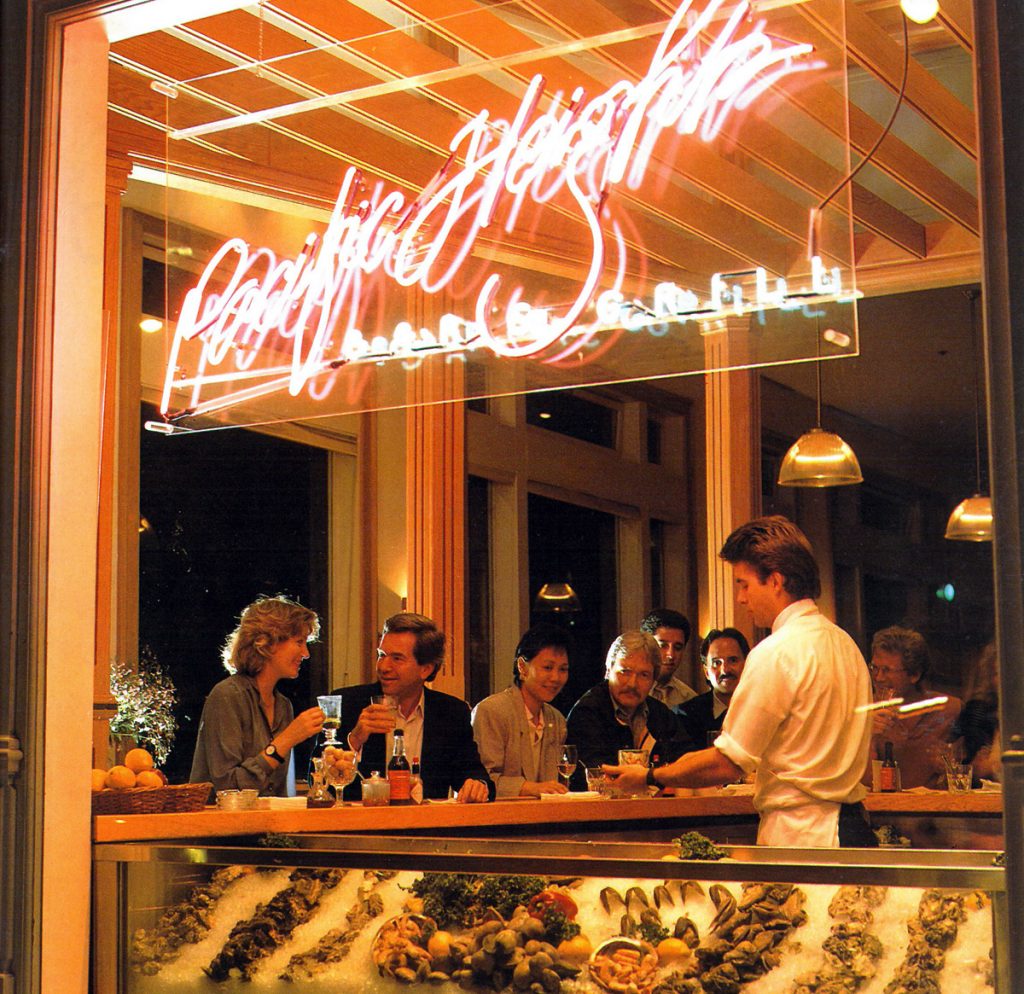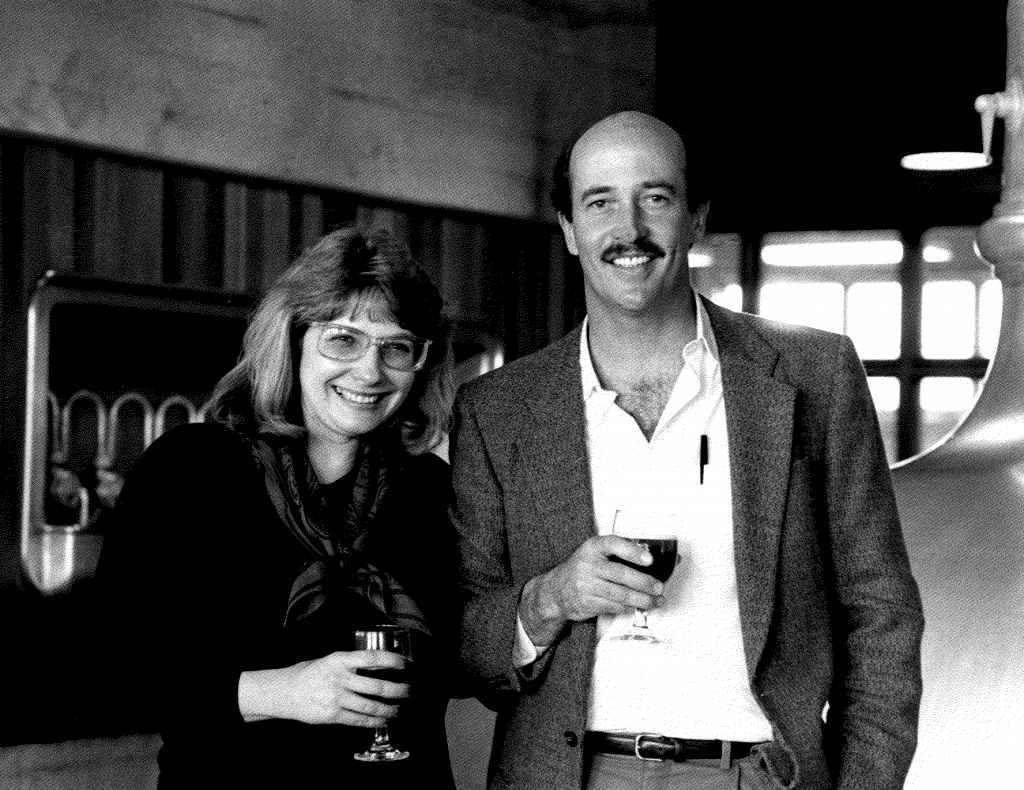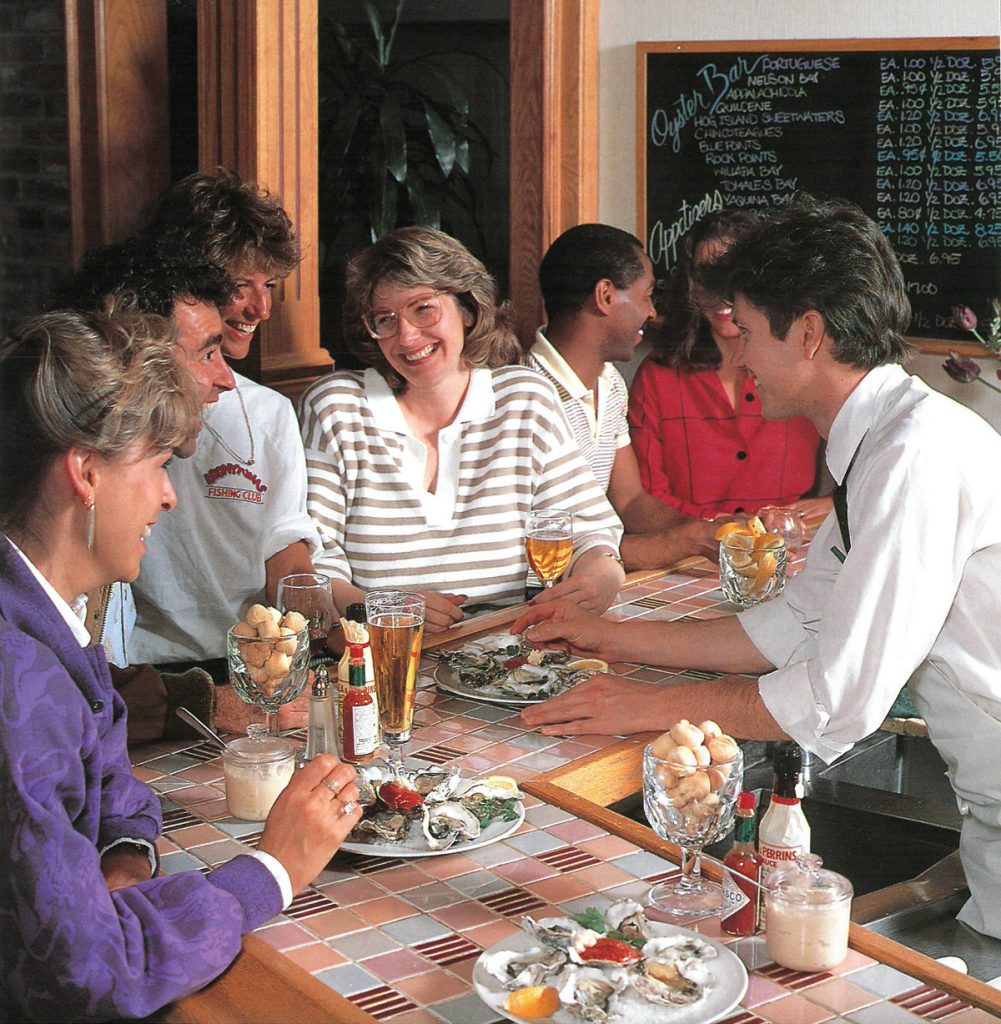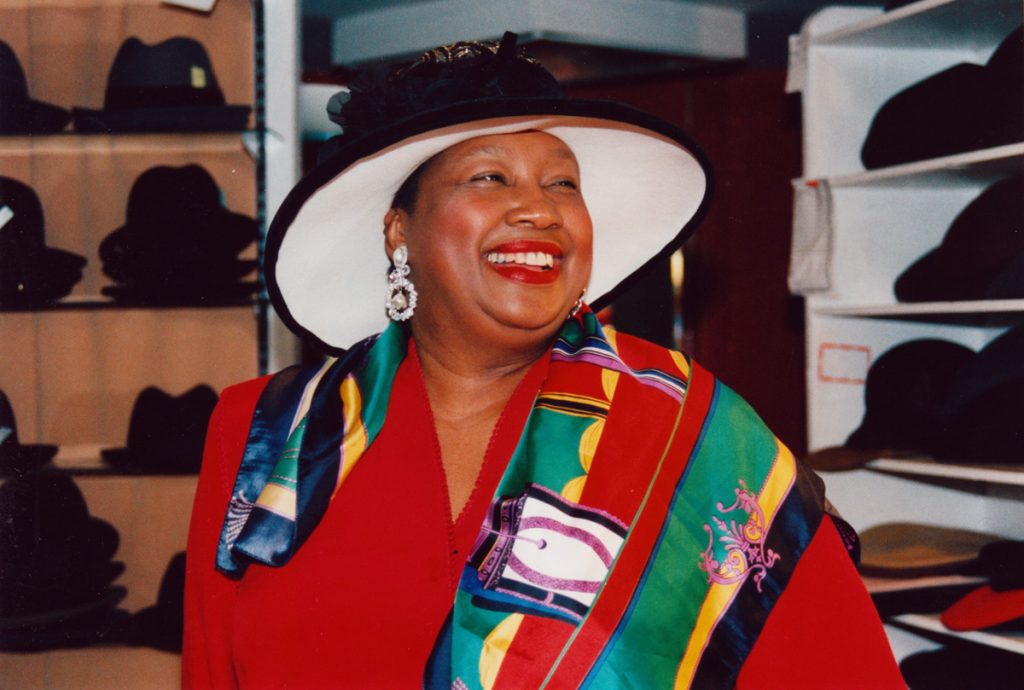
By THOMAS REYNOLDS
Behind the crowds queueing up outside the hot new restaurant Noosh, on the corner of Fillmore and Pine, is a small brass plaque recalling an earlier incarnation of the space when it was home to the late and much-lamented Pacific Heights Bar & Grill.
The PacBag, as it was known, was a pioneering restaurant that reigned as the neighborhood’s living room for a decade.
“It was the neighborhood Cheers,” the bar on the television show where everybody knows your name, says Marilyn Fisher, a lawyer who lived nearby and was a regular.
“It was like Cheers,” agrees co-owner Susie Bashel. “People came in almost every day.”
Before the PacBag opened in 1984 — and definitely before the Elite Cafe opened on the same block in 1981 — California Street was the dividing line between upper and lower Fillmore.
“People farther north started migrating down,” says longtime neighborhood resident Ronald Hobbs, who ran Spectrum Exotic Birds next door to the PacBag and became one of the regulars. “Before, anything south of California Street was sketchy.”
Hobbs says the new restaurant, with its extensive oyster bar in the front window, was several cuts above most of its neighbors. “It was!” he says. “I put on a white shirt. I’d clean my fingernails.”
It all started when a runaway Muni bus plowed through the front door one afternoon and knocked the building off its foundation. The repairs offered the opportunity to do seismic work and upgrade the interior, too, which had previously housed an antiques shop and a plant store.
“We got a little more ambitious,” says Bashel, who ran the restaurant with her husband, Craig.
They had come up from Southern California to open a restaurant in Santa Rosa, or perhaps Sonoma. Instead they decided to partner with a friend who had a place on Polk Street.
“Then this idea bloomed,” says Bashel. “Honestly, we were so young and so green. It just took off.”
The oyster bar in the front window was a visible draw, and operated on a scale seen nowhere else in town, and few other places anywhere.
“We had a terrific selection of oysters — sometimes 20 kinds a day,” says Bashel. They were sent by UPS. “We’d go down to the airport to pick them up. Nobody was doing what we were doing.”
And there was a long new drinking bar visible from both Pine and Fillmore.
“It had that huge bar — 22 seats,” Bashel says. “We had all kinds of regulars. It turned into a neighborhood place, but with a little glamour.”
Herb Caen helped. The legendary Chronicle columnist reported one day that the seafood at the PacBag was so fresh that chef Lonnie Williams had “reached into the refrigerator for a piece of fish and was bitten on the index finger by a quite live 30-pound halibut.” Caen added: “The fish aren’t taking this lying down.”
Williams and server Karen Warner wrote a book — Oysters: A Connoisseur’s Guide & Cookbook — that capitalized on the restaurant’s claim as one of the best-stocked oyster bars in the nation. The beautiful little book remains a collector’s item.
As the restaurant’s reputation grew — Orville Schell in California magazine called it “the best seafood this side of a sandbar” — people came from all over. But the locals considered it their own.
“We were patronized by people who lived nearby,” Bashel says. “And so many people knew each other. You’d walk in and talk to four or five people on your way down the bar.”
The San Francisco International Film Festival was then held every year at the swanky new Kabuki cinemas on Post Street, and would always buy out the PacBag for a party. Robert and Magrit Mondavi took it over to promote their winery.
“Robin Williams lived nearby and would always come in and get take-out for 15 or 20 people,” says Bashel. “It was wildly expensive.”
One of the most regular regulars even got married at the PacBag — to someone he’d met at the bar.
The restaurant had a carefully crafted wine program, too. Bashel herself was in charge of choosing the wines.
“Anthony Dias Blue lived in the neighborhood,” Bashel says. “His Bon Appetit wine tasting panel met upstairs at the PacBag for a couple of years. He let me taste with them — tasting, and just listening.”
Many of the regulars were baseball fans, so once or twice a season the PacBag would rent a bus and provide the food and drinks for a tailgate party at a Giants game. “Those were a blast,” Bashel remembers.
It all seemed like something of a dream.
“I never thought we would have a restaurant like that,” she says. “Our goals and our vision were much smaller. It was thrilling.”
Then came the Loma Prieta earthquake on October 17, 1989. Some of the regulars were at the World Series game at Candlestick Park, and others gathered at the PacBag to watch on television.
“I was cleaning out the cages in the bird store and it started shaking,” recalls Ronald Hobbs. “When things settled down, I went into the PacBag and took somebody’s drink — I couldn’t wait for my own.”
The quake signaled the beginning of the end for the PacBag.
“It was a great business, until the earthquake hit in 1989,” Bashel says. “It was never quite the same. We never quite recovered from the earthquake.”
Locals still came in for a cocktail after work, but the Bay Bridge was closed, cutting off fans from the East Bay. The owners hung on for a few more years before finally calling it quits in 1994.
“We were getting close to the end of our 10-year lease,” Bashel recalls. “Business had declined to the point that we felt we should let it die a natural death. It was super-hard. It was really sad.”
Eventually they made their way north to Oregon.
“We made a conscious decision to get out of seafood and do something more affordable — something with a bigger audience and more potential customers. The Portland restaurant scene was just starting and offered a lot more opportunity.”
They found success of a different kind when they opened Pastini, a casual Italian restaurant, in Portland. Now, 25 years after they left Fillmore, they have three Pastinis in Portland and five more in the suburbs and other parts of Oregon.
They have fond memories, but no second thoughts about closing the PacBag.
“I think it was the right time,” Bashel says. “We regret only that we had to leave. It was one of the best parts of my life — all the friends I made that I still have, and living in San Francisco, which was wonderful. We have so many good memories and met so many good people. It was an amazing experience for us.”

Among friends when the ’89 earthquake hit
By MARILYN FISHER
A regular at the PacBag
I left the office about 4:35 that afternoon — October 17, 1989 — to get a decent seat at the Pacific Heights Bar & Grill to watch the third game of the World Series. I had been there about five minutes when the earthquake hit at 5:04 p.m.
It started with a slight jolt and a rumble, similar to a bus going by. Then someone near me yelled “earthquake” and it was apparent it wasn’t just a bus.
I dived under a nearby table and a girl sitting next to me dived there, too. We held on to the pedestal table as it jerked up and down. There was an incredible roaring sound. I thought the walls would come tumbling down. But they didn’t, and then it was over, with no damage at all, not a single broken bottle or glass.
Like the vast majority of people, we had no idea how bad it was, and at first assumed the game would soon continue, although the power was out and the television, obviously, dark.
A large transistor radio was brought out from the kitchen and a group of us stayed glued to it for several minutes. The first reports were sketchy and confused. People ordered drinks and were in a crazy, scared but almost cheerful mood — until we heard on the radio that a portion of the Bay Bridge and a freeway in Oakland were down.
Next we heard about a terrible fire and buildings collapsing in the Marina. People who lived out of the city began scampering for pay phones, many of which were not working, although some were.
As it got dark, Susie and Craig Bashel, the owners of the PacBag, closed to non-regulars and locked the door. They brought out candles and served drinks to the regulars. Eventually most of our crowd who had gone to Candlestick Park for the game knocked on the door and filtered in.
The PacBag was such an integral part of our neighborhood community, a place so many of us knew we would always see friends, beginning with Susie and Craig — a natural place to gravitate to in good times and bad. I think we all felt a little more complete that night when the contingent that had been at the ball park arrived and joined us in the candlelight.
We all left about 11 p.m., and I was fortunate that a friend who lived in my building had arrived with a flashlight. Another friend drove us home, through streets pitch dark and quiet. I know I slept some that night, but sleeping was not easy in the aftermath of the earthquake.
The next day, Wednesday, October 18, was a strange day. Most of us in the neighborhood still had no electrical power. Some of the commercial establishments on Fillmore or nearby did have power — including the Grand Central Market — but it was sporadic. The PacBag and my apartment building had no power until Thursday morning.
Although there was no damage where I lived at Bush and Webster, we were only 15 blocks from the Marina, which was heavily damaged. In the first several days after the quake, it seemed unfair, and made our neighborhood feel almost guilty that we were okay while there was such devastation so close by.
There were early reports of severe damage at my law office downtown, but almost nobody even attempted to call others about work until Friday, October 20, when most parts of the city had power restored.
Three days later, after the weekend, they told us it was safe to go back to work, despite previous reports about asbestos and structural damage. The old half of our building was condemned, but the new part, built in 1957, was determined to be safe.

‘The Cheers of San Francisco’
By JOEL BERGE
Bar manager at the PacBag
I have so many fond memories of the Pacific Heights Bar & Grill that I could write a book. First off, the PacBag was the PacBag because of Susie and Craig Bashel, two of the greatest people I have ever met, let alone had the honor to work for. All the great events we had and the loyal clientele that supported us were due to the goodwill of those two people.
I spent the best decade of my life on the corner of Fillmore and Pine. We had so many great times at that bar most people called “the Cheers of San Francisco.” All the same guests would come night after night and rehash the day’s events, and it was not uncommon for us to hang out together on our days off. We all really enjoyed each other’s company.
I threw an annual Thanksgiving dinner at my home every year for all the misfits who had no place to go. It ended up being quite an ordeal. I think I had 50 guests the last couple of years. They were by far my favorite Thanksgivings to date.
We would also buy blocks of Giants tickets and meet at the bar on a Sunday morning for Bloody Marys, then jump on a chartered bus and head to Candlestick to tailgate and spend a day of fun in the sun. Susie and Craig never took their tailgates lightly. We’d have barbequed oysters with pesto and asiago cheese, ribs, New York steaks, always a nice keg of beer and plenty of wine for all. It was so much fun. I’m sure the bartenders working the bar when we returned were biting their tongues and praying we’d all soon disperse.
We had the best oyster bar in the city with more than a dozen different oysters every day. It was quite a feat to keep that kind of inventory, but Craig made sure we had the variety. He also provided trips for the staff to Bodega Bay and the oyster farms so that we all knew about the farming and the work it took to keep these mollusks on a menu.
Susie always had the best wines and sparkling wines to pair with each oyster. She was quite the wine master. She had an incredible reputation in the business for her knowledge and insight — so much so that Robert Mondavi chose to pair his wine with the dishes of PacBag Chef Lonnie Williams. That provided for a night we’ll all never forget.
My part in the PacBag was melding the oil-and-water colorful honyokers that loitered in the bar each night. What an eclectic array of guests we had! My favorite would have to be Marilyn Fisher, who I considered my personal attorney. More than once she helped me with legal issues, and she did the same for a slew of others by giving free legal advice. After overserving her for many years, I had the honor of driving her to sobriety, which she still is today, must be 30 years later. She will always have a special place in my heart.
Chuck Bernard and wife Beryl were nightly inhabitants, along with Ronald Hobbs, Ruth Dewson, Danny E., Craig Martin, Mr. Nash, Bob Swig, Dino, Harry Denton, on occasion Robin Williams, Willie and Jerry Brown. These were just a dabbling of the cast of characters who would pop in to the PacBag. It was a hip little spot in the ’80s and early ’90s.
The earthquake was quite a day. I was at Candlestick when it hit and spent the next couple of hours navigating traffic with no traffic lights. I first drove to the PacBag, only to find the bar full in the dim candlelit space. It was like everyone was waiting for me to get back from the ballpark to make sure I was okay, and then everybody wrapped it up and slowly went home. Those who didn’t leave I took home to my place, and we stayed up all night waiting for the electricity to come back on. I had some upset neighbors.
I do remember calling my parents from the pay phone at the PacBag and letting them know I was safe. I shed a few tears in that conversation, and I’m sure alcohol had nothing to do with that.
Those were also the toughest 10 years of my life. It was such a great family, and we lost several family members to the AIDS epidemic that infiltrated the city. Losing so many young men in such a short period of time was a real test of strength. There were many days when going to work was a chore, knowing that certain people were not going to be a part of the puzzle any more.
It was a morale buster and, probably more than any other reason, the fatigue factor that led me to find a different space. Telling Susie and Craig I was moving on was not an easy thing to do. But for my own peace of mind, I needed the change, leaving behind the best 10 years of my life.

Watering at the same well
By RONALD HOBBS
A regular at the PacBag
The place was jammed, the Pacific Heights Bar & Grill. We had just come from St. Dominic’s after listening to Mother Teresa speak of terrible sufferings in Calcutta. During the offertory, the long-armed baskets heaped with the long green. And in those days there was the “AIDS thing” going on. But it was most likely guilt, not conscience, that stuffed the coffers.
I suppose it did not matter, for money is a measure of sincerity.
At the time I was not well fixed, and practicality has never been my long suit. But I was walking in a $200 pair of shoes and wearing a $50 necktie. And now I had an $8 glass of Cabernet sitting in front of me. A half-dozen oysters would run me that twice. Of the gathered crowd I was one of the minnows. If I sipped slowly, I could ride this for another couple of hours.
The crowd thinned at about 10 and I cashed out with a generous tip, about the same as I put into the long arm of guilt. I left with $6. Pathetic, I know. But I wanted to see it through. I hung my clothes not so neatly. I was drunk in some indefinable way, not the .08% way.
I did not fully believe Mother Teresa, my shoes, the oysters, the necktie. And I didn’t give a shit about lepers or orphans in Calcutta. I lit a cigarette and turned on the 10 o’clock news.

Big butterfly paint-lipped Ruth Dewson was a lost soul in a sleek red Cadillac. She did nails and eyebrows before she got into hats. Hats made her famous.
We used to water at the same well, the Pacific Heights Bar & Grill, after work. That place was the neighborhood bar, but not one of your yahoo show-your-ass joints. It was real. It had the odor of privilege, but it didn’t stink. And it was home-like.
Ruth often excused herself to the ladies room, leaving her checkbook open. And I or one person or another who was sitting at hand could see the check stubs written to “Friends of the committee for (name your politician).”
She was a large and voluptuous woman — fun and funny — and a conniving bitch. A little girl wanting to be grown up. She wanted to prove something to Paris, Texas, her hometown. But mostly she wanted to prove something to herself.
So interesting, this business of being alive.
Filed under: Food, Drink & Lodging




